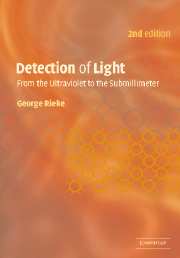Book contents
- Frontmatter
- Contents
- Preface
- 1 Introduction
- 2 Intrinsic photoconductors
- 3 Extrinsic photoconductors
- 4 Photodiodes and other junction-based detectors
- 5 Amplifiers and readouts
- 6 Arrays
- 7 Photoemissive detectors
- 8 Photography
- 9 Bolometers and other thermal detectors
- 10 Visible and infrared coherent receivers
- 11 Submillimeter- and millimeter-wave heterodyne receivers
- 12 Summary
- Appendices
- References
- Index
6 - Arrays
Published online by Cambridge University Press: 09 November 2009
- Frontmatter
- Contents
- Preface
- 1 Introduction
- 2 Intrinsic photoconductors
- 3 Extrinsic photoconductors
- 4 Photodiodes and other junction-based detectors
- 5 Amplifiers and readouts
- 6 Arrays
- 7 Photoemissive detectors
- 8 Photography
- 9 Bolometers and other thermal detectors
- 10 Visible and infrared coherent receivers
- 11 Submillimeter- and millimeter-wave heterodyne receivers
- 12 Summary
- Appendices
- References
- Index
Summary
Photoconductors and photodiodes are combined with electronic readouts to make detector arrays. The progress in integrated circuit design and fabrication techniques has resulted in continued rapid growth in the size and performance of these solid state arrays. In the infrared, these devices are based on a (conceptually) simple combination of components that have already been discussed; an array of integrating amplifiers is connected to an array of detectors. These devices can provide thousands to millions of detector elements, each of which performs near the fundamental photon noise limit for most applications between wavelengths of 1 and 40 μm. For visible and near-infrared detection, monolithic structures can be built in silicon to form arrays with millions of high performance pixels. The most highly developed of these visible detectors is the charge coupled device, or CCD, which combines an array of intrinsic photoconductors, a sequentially addressable array of integrating capacitors, and a FET output amplifier, all built together on a single wafer of silicon. Operated at low temperatures, CCDs can reach fundamental detection limits for virtually all applications between wavelengths of ∼0.1 nm (in the X-ray region) and ∼1 μm (in the near infrared), except when rapid time response is required. So-called CMOS imaging arrays are an alternative to CCDs.
- Type
- Chapter
- Information
- Detection of LightFrom the Ultraviolet to the Submillimeter, pp. 145 - 186Publisher: Cambridge University PressPrint publication year: 2002



